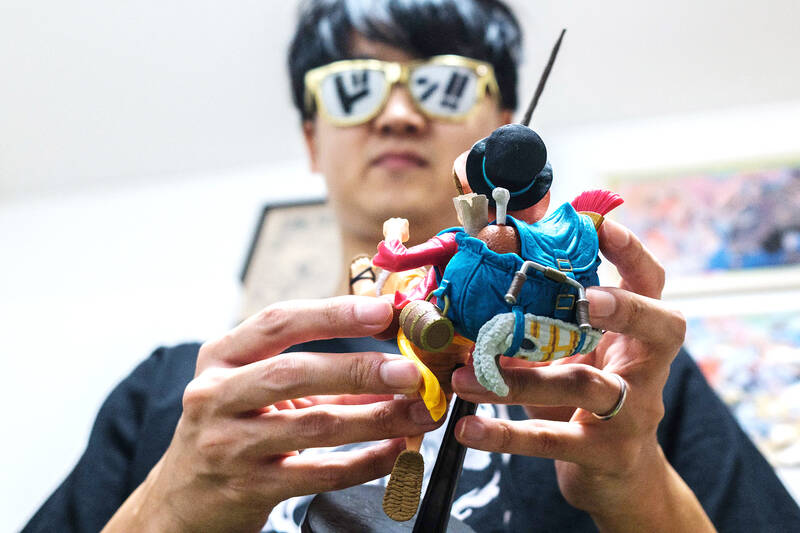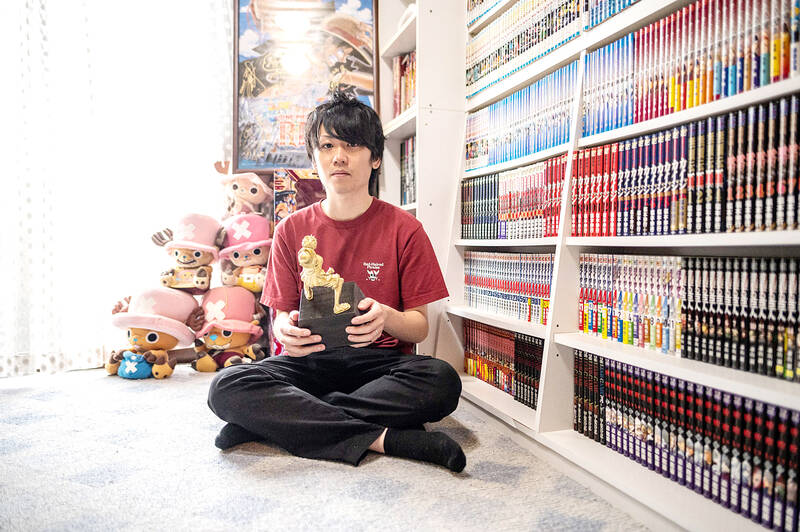Shohei Sato’s devotion to the pirate manga One Piece culminated in a wedding themed on the series, and he’s not the only superfan obsessed with its intricate plots and swashbuckling characters.
The Japanese comic-book saga began 25 years ago and is one of the biggest-selling mangas of all time, with more than 500 million copies sold globally.
It follows straw hat-wearing Monkey D. Luffy and his team as they hunt for treasure, and has grown into a sprawling cultural franchise — now riding even greater waves of popularity thanks to a new hit film and an upcoming live-action Netflix series.

Photo: AFP
Since childhood, 29-year-old Sato estimates he has spent “well over 10 million yen (US$67,000 at current rates), if not 20 million” amassing merchandise and crisscrossing Japan to attend One Piece events.
So the office worker’s friends weren’t surprised when he and his bride Junna had a pirate-ship cake at their wedding in July and posed for photos beside a giant poster of Luffy and his gang in formal attire.
“They told me, ‘Shohei, it was so you,’” Sato said at his home in Tokyo, where plush toys of the reindeer-like character Chopper sit next to bookshelves packed with One Piece volumes.

Photo: AFP
“I’ve lived my whole life alongside One Piece, so I wanted my wedding to honor it.”
The latest movie in the franchise, One Piece Film: Red, was released in August and is already Japan’s highest-grossing film this year.
Sato has seen it 21 times.

Photo: AFP
The film has also been a hit abroad, especially in France, while fans came out in costume for a huge Times Square ad campaign ahead of the US release in November.
‘KNOWLEDGE KING’
Inspiring dialogue, clever foreshadowing and relatable characters — author Eiichiro Oda is said to shed tears as he draws them crying — are often cited by One Piece superfans as the reason for their infatuation.
The manga’s plots are so intricate that publisher Shueisha holds a yearly quiz in which tens of thousands of fans compete to become its “knowledge king.”
Sato once came in 10th, winning a golden trophy.
Another regular contestant, whose record is 15th place, is a systems engineer who goes by the online moniker Arimo.
Every night, after tucking his son into bed, the 32-year-old reads One Piece in his study, which is decorated with illustrations from the series.
Even the walls of Arimo’s toilet are plastered with pages from the manga, and the geography-lover has crafted his own globe to map the islands and oceans explored by Luffy.
“The One Piece world is so meticulously thought-out, I sometimes feel like there’s truly an alternative universe like this somewhere,” Arimo said.
One Piece is serialized in the weekly Shonen Jump magazine, which is aimed at teenage boys.
But its exaggerated humor, adrenalized action scenes and hundreds of varied characters appeal to a far broader readership.
‘ONE PIECE IS MY ENERGY’
Natsumi Takezawa, 34, said she had “forgotten One Piece is supposed to be a boy’s manga,” because it “strikes a chord with all generations.”
She works part-time and reads One Piece for a little relaxation after picking up her five-year-old daughter from nursery, making dinner, bathing and playing with her, before finally putting her to bed.
“Without One Piece, I might feel drained,” she said. “I might be too exhausted by chores to do anything but sleep. That’s all my life could’ve been about. One Piece is my energy.”
Takezawa says the manga has even helped her with grief.
Seeing the bawling Luffy realize “I still have my friends” after the death of his brother resonated deeply after she lost a close friend this year.
“What kind of experience does a person have to go through to be able to draw such a powerful scene?” she said.
The One Piece saga entered its final arc in July.
Oda said in 2019 that he wants to wrap up the story “within five years,” technically leaving little time until its conclusion.
Sato thinks “another seven to eight years” would be a reasonable bet, however.
“One Piece is part of my life now, so I definitely want to see it through to the end,” he said.
“Until then, I refuse to die.”

The canonical shot of an East Asian city is a night skyline studded with towering apartment and office buildings, bright with neon and plastic signage, a landscape of energy and modernity. Another classic image is the same city seen from above, in which identical apartment towers march across the city, spilling out over nearby geography, like stylized soldiers colonizing new territory in a board game. Densely populated dynamic conurbations of money, technological innovation and convenience, it is hard to see the cities of East Asia as what they truly are: necropolises. Why is this? The East Asian development model, with

June 16 to June 22 The following flyer appeared on the streets of Hsinchu on June 12, 1895: “Taipei has already fallen to the Japanese barbarians, who have brought great misery to our land and people. We heard that the Japanese occupiers will tax our gardens, our houses, our bodies, and even our chickens, dogs, cows and pigs. They wear their hair wild, carve their teeth, tattoo their foreheads, wear strange clothes and speak a strange language. How can we be ruled by such people?” Posted by civilian militia leader Wu Tang-hsing (吳湯興), it was a call to arms to retake

Desperate dads meet in car parks to exchange packets; exhausted parents slip it into their kids’ drinks; families wait months for prescriptions buy it “off label.” But is it worth the risk? “The first time I gave him a gummy, I thought, ‘Oh my God, have I killed him?’ He just passed out in front of the TV. That never happens.” Jen remembers giving her son, David, six, melatonin to help him sleep. She got them from a friend, a pediatrician who gave them to her own child. “It was sort of hilarious. She had half a tub of gummies,

The wide-screen spectacle of Formula One gets a gleaming, rip-roaring workout in Joseph Kosinski’s F1, a fine-tuned machine of a movie that, in its most riveting racing scenes, approaches a kind of high-speed splendor. Kosinski, who last endeavored to put moviegoers in the seat of a fighter jet in Top Gun: Maverick, has moved to the open cockpits of Formula One with much the same affection, if not outright need, for speed. A lot of the same team is back. Jerry Bruckheimer produces. Ehren Kruger, a co-writer on Maverick, takes sole credit here. Hans Zimmer, a co-composer previously, supplies the thumping